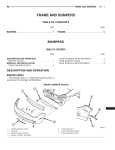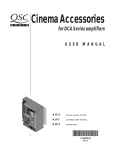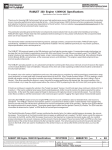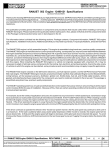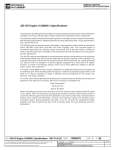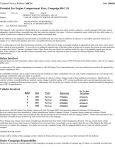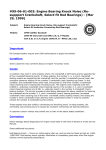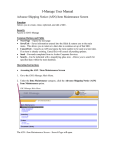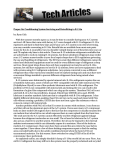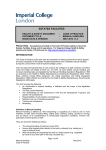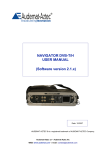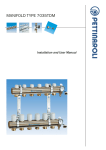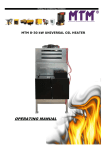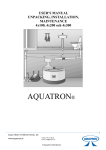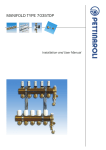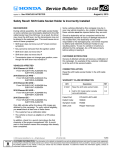Download 1 - FieroNews
Transcript
Technical Service Bulletin # 88C23 Date: 900601 Potential For Engine Fires Number 88-C-23 Subject: Date 06/90 PRODUCT SAFETY CAMPAIGN - 88-C-23 LACK OF ADEQUATE SERVICE OR MAINTENANCE MODELS AFFECTED 1984-88 PONTIAC FIERO MODELS WITH 2.5L L4 ENGINES (RPO LR8) "THIS CAMPAIGN BULLETIN SUPPLEMENTS CAMPAIGN BULLETIN 84-C-15B DATED MARCH 1989 AND SUPERSEDES CAMPAIGN BULLETIN 87-C-11 DATED JANUARY 1989. PLEASE DISCARD BULLETIN 87-C-11." TO: ALL PONTIAC DEALERS The National Traffic and Motor Vehicle Safety Act, as amended, provides that each vehicle which is subject to a recall campaign of this type, must be adequately repaired within a reasonable time after the owner has tendered it for repair. A failure to adequately repair within sixty days after tender of a vehicle is prima facie evidence of failure to repair within a reasonable time. If the condition is not adequately repaired within a reasonable time, the owner may be entitled to an identical or reasonably equivalent vehicle at no charge or to a refund of the purchase price less a reasonable allowance for depreciation. To avoid having to provide these burdensome solutions, every effort must be made to promptly schedule an appointment with each owner and to repair their vehicle as soon as possible. As you will see in reading the attached copy of the letter which is being sent to owners, the owners are being instructed to contact the Pontiac Customer Assistance Center if their dealer does not remedy the condition within five days of the mutually agreed upon service date. If the condition is not remedied within a reasonable time, owners are instructed on how to contact the National Highway Traffic Safety Administration. Defect Involved General Motors has detemined that a defect which relates to motor vehicle safety exists in 1984-88 Pontiac Fiero Model vehicles with 2.5L L4 engines (RPO LR8). An interaction of the engine compartment environment in 1984-88 Pontiac Fiero's and maintenance or service related factors results in the potential for engine compartment fires. If combustible materials come in contact with the exhaust manifold, an engine compartment fire can result. Engine compartment fires can spread to the passenger compartment and cause injury to occupants. To reduce the possibility of this condition occurring, all vehicles will have changes made in their underhood environment. Specifically, all vehicles will have a manifold barrier installed, a minor change to decklid sealing, and a general inspection (and repair as necessary) of underhood fluid and wiring systems. Additionally, 1984-86 model year vehicles will have a new exhaust manifold installed to bring them up to 1987-88 specifications. Vehicles Involved Involved are certain 1984-88 Pontiac Fiero Model vehicles with 2.5L L4 engines (RPO LR8) produced within the following VIN breakpoints: Involved vehicles have been identified by Vehicle Identification Number Computer Listings. Computer listings contain the complete Vehicle Identification Number, owner name and address data, and are furnished to involved dealers with the campaign bulletin. Owner name and address data furnished will enable dealers to follow-up with owners involved in this campaign. These listings may contain owner names and addresses obtained from State Motor Vehicle Registration Records. The use of such motor vehicle registration data for any other reason is a violation of law in several states. Accordingly, you are urged to limit the use of this listing to the follow-up necessary to cornplete this campaign. Any dealer not receiving a computer listing with the campaign bulletin has no involved vehicles currently assigned. OWNER NOTIFICATION Owners will be notified of this campaign on their vehicles by Pontiac Division (see copy of owner letter included with this bulletin). Dealer Campaign Responsibility Dealers are to service all vehicles subject to this campaign at no charge to owners, regardless of mileage, age of vehicle, or ownership, from this time forward. Whenever a vehicle subject to this campaign is taken into your new or used vehicle inventory, or it is in your dealership tor service in the future, you should take the steps necessary to be sure the campaign correction has been made before reselling or releasing the vehicle. Owners of vehicles recently sold from your new vehicle inventory are to be contacted by the dealer, and arrangements made to make the required correction according to instructions contained in this bulletin. Parts Information ILLUSTRATION A - 1984-86 MODELS ILLUSTRATION B - 1987 MODELS ILLUSTRATION C - 1988 MODELS Parts required to complete this campaign are to be obtained from General Motors Service Parts Operations (GMSPO). To ensure that these parts will be obtained as soon as possible, they should be ordered from GMSPO on a "C.I.O." order with no special instruction code, but on an advise code (2). Breakdown of the specific parts included in these kits are shown on the applicable illustrations. Additional parts necessary to correct engine compartment fluid leaks, or cooling system discrepancies, etc., are to be ordered from GMSPO as required from the appropriate service parts catalog. NOTE: This campaign effectively supplements campaign bulletin 84-C-15B and supersedes campaign bulletin 87-C-11. The following parts cannot be ordered from GMSPO and dealers should contact the zone if additional parts are needed. 84-C-15B 87-C-11 Service Procedure NOTE: The "Check Oil" reminder label and/or glove box supplements for Campaign 84-C-15B and/or 87-C-11 should be taken care of at this time if they are still open. To reduce the effects of fluid leaks which may lead to engine compartment fires, Pontiac dealers will do the following at no charge: 1. INSTALL EXHAUST MANIFOLD SHIELD a. Remove right side grille panel & disconnect negative battery cable. ILLUSTRATION D (Deck Lid) b. Remove rear engine compartment lid (on 1984 models also remove center grille from engine compartment lid). Remove rubber dust seal and retaining clips (rivets) from leading edge (front) of decklid assembly (and leave off). On 1984 vehicles, remove plastic deflector from underside of decklid grille opening (and leave off); reinstall center grille. (See Illustration D for component identification.) c. Remove air cleaner assembly. d. Remove dipstick tube. e. Disconnect 02 sensor wire. f. Raise vehicle. g. Remove and discard convertor splash shields (only on 1984-85). h. Remove convertor pipe to exhaust manifold bolts. j. Remove A/C mount bracket bolt and install new stud-headed bolt (# 3) in block above oil pan rail at A/C bracket. Spacer (1984-86: # 4 WITHOUT A/C or NO Spacer WITH A/C; 1987 & 88: # 4 - WITHOUT A/C or # 26 WITH A/C) to be installed on stud. Lower vehicle. k. Remove exhaust manifold and gasket. l. Clean gasket surface on cylinder head and exhaust manifold if a new manifold is not installed. m. i. ILLUSTRATION E (Harness Taping) Install protective tape wrap (provided in kit) on engine wiring harness starting at themostat housing and ending at bulkhead connector on 1984 vehicles (Illustration E). ILLUSTRATION A - 1984-86 MODELS ILLUSTRATION B - 1987 MODELS ILLUSTRATION C - 1988 MODELS n. Install new cylinder head bolts (1984-86 vehicles only) provided in kits. New cylinder head bolts should be installed using torque values described in Illustration A & B. HEAD BOLTS SHOULD BE REPLACED ONE AT A TIME. If a broken head bolt is encountered, refer to Dealer Service Bulletin 87-6(GAS)-94 for the proper procedure. o. Install new 02 sensor (# 21, 1984-86) in exhaust manifold. p. Install deflector (# 2), gasket (# 23), and exhaust manifold (# 7) (new manifold provided for 84-86 vehicles). Shield is not gasketed against cylinder head. Note that shield leg/bracket has different spacers (# 4 or # 26) or no spacer depending upon model year and equipment. q. Manifold bolts should be installed using torque values described in Illustration A, B & C. Lock tabs (# 6, 1984-88) should be installed on outboard manifold runner bolts. r. Install dipstick tube. s. Install new exhaust pipe seal. Loosely install one (1) convertor pipe to exhaust manifold bolt (# 12). t. Raise vehicle. u. Install remaining manifold to convertor pipe bolt (# 12) and tighten using torque values described in Illustration A & B. v. Install shield leg nut (# 5) and washer (# 19) and tighten using torque values described in Illustration A, B & C. w. x. Lower vehicle. Remove starter motor heat shield and clamps (may already be removed) from exhaust manifold to convertor exhaust pipe. y. Install new heat stove (# 20 & 25, 1984-86 only) as shown in Illustration A with band clamps (# 20) on front pipes. z. Install air cleaner assembly. aa. Connect negative battery cable and install right side grille panel. NOTE: 2. THE REMAINING STEPS BELOW ARE INSPECTION ITEMS. IT IS IMPERATIVE THAT CARE BE EXERCISED IN INSPECTION. THE PARTICULAR ITEMS HAVE BEEN CHOSEN DUE TO THEIR POTENTIAL ASSOCIATION WITH UNDERHOOD FIRE. SEE THE NOTES ON EACH STEP FOR THE TYPES OF REPAIRS AUTHORIZED. * PRIOR TO PERFORMING THESE INSPECTIONS, THE TRAINING MOVIE "WINNERS DO IT RIGHT" (MAILED SEPT. 1989) SHOULD BE VIEWED. * PLEASE NOTIFY YOUR CUSTOMER OF ANY ISSUES NOT FIXED IN YOUR INSPECTION WHICH WILL BE HIS/HER RESPONSIBILITY. * ANY ISSUES NOT SPECIFICALLY AUTHORIZED IN THIS BULLETIN MAY BE DISCUSSED WITH YOUR APPROPRIATE ZONE CONTACT PERSON WITH SERVICE RESPONSIBILITY INSPECT COOLING SYSTEM a. Visual check of coolant level. Adding needed coolant to specified level and/or diagnostic procedure will be authorized if coolant loss is determined to be a chronic problem. NOTE: With engine cold, perform a pressurized leak test as described in 1986 Fiero Service Manual Section 6B-14, 15. b. Visually inspect for significant leaks. Repairs are authorized for external coolant leaks from any engine compartment area, specifically thermostat housing, water pump, coolant hoses and connectors in engine compartment. C. Visually inspect for signs of coolant hose wear or aging. Replacement of damaged hoses is authorized. d. Perform a function check of cooling fan. Replacement of relay, coolant switch, wiring or fan is authorized to make functional. ILLUSTRATION F - 1984-88 MODELS (Heat Shields) ILLUSTRATION G - 1984-86 MODELS (Heat Shields) 3. INSPECT EXHAUST SYSTEM a. Observe for any significant leaks (vehicle running). Repairs are authorized for any leaks forward of the catalytic convertor. Also repairs should be made if any irregularity in manifold or front pipe prevents proper installation of the new shield. b. 4. 5. 6. Visually inspect for presence of appropriate heat shields. Repair or replacement will be authorized for starter shield, convertor shield, muffler shield, or bulkhead shields. See Illustrations F and G for correct configurations. INSPECT LUBRICATION SYSTEM a. Visually inspect for indications of significant oil leakage. Repairs for seepage will not be authorized, only areas with significant leakage. Specifically, rocker cover gasket repair or PCV breather are authorized. Oil pan or filter leaks are not nomally covered. b. Visually verify update to 4 quart system. Vehicles should all be equipped with the larger oil filter APF51 style). Replacement of the filter is authorized if vehicle was not previously retrofit. c. Check oil level. Make-up oil authorized for vehicles 1 quart or more low. INSPECT FUEL SYSTEM a. Visually inspect for signs of leakage inside engine compartment. Repairs are authorized for retorque, new fitting, or hose replacement. b. Visually inspect evaporative emission system for integrity of harness connections. Reinstallation of harness authorized if necessary. Tampered systems to be replaced only if vapor lines were left open (presenting some fire risk). All emission discrepancies should be noted in writing to the owner and noted on the repair order. INSPECT TRANSMISSION OIL COOLER a. 7. INSPECT IGNITION SYSTEM a. 8. 9. Visually inspect for signs of oil cooler hose leakage near transmission. Repairs are authorized for hose degradation or fitting tighten/replace. Visually inspect for proper spark plug wire routing. Rerouting authorized if required and replacement of spark plug wire retainer clips only. INSPECT ENGINE COMPARTMENT WIRING a. Visually inspect for correct routing of engine wiring harness in vicinity of exhaust manifold. Reroute and clip as necessary. b. Visually inspect for correct battery cable routing. Reroute and clip if required. c. Visually inspect for any obvious chafing/wear on starting/charging circuit wiring. Wire, conduit or retainer replacement authorized if necessary. VISUALLY INSPECT FOR ANY COMBUSTIBLE MATERIALS HANGING LOOSE IN FRONT OF ENGINE COMPARTMENT. (e.g. conduit, insulation) Remove as required. 10. Install rear engine compartment lid and left side grille panel. NOTE THAT COMPONENTS ON THE BULKHEAD WILL NOW BE BARELY VISIBLE FROM OUTSIDE THE VEHICLE WITH THE ENGINE COMPARTMENT LID CLOSED. THIS CHANGE INCREASES AIR FLOW THROUGH THE ENGINE COMPARTMENT. SHOULD YOUR CUSTOMER WISH, THE VISIBLE BULKHEAD COMPONENTS MAY BE SPRAYED FLAT BLACK. 11. Install campaign identification label. Campaign Identification Label Each vehicle corrected in accordance with the instructions outlined in this Product Campaign Bulletin will require a "Campaign Identification Label." Each label provides a space to include the campaign number, the five (5) digit dealer code of the dealer performing the campaign service and the date the vehicle was campaigned. This information may be inserted with a typewriter or a ball point pen. Install the label only on underside of decklid where it is readily visible (additional campaign labels are available on stationary order as Form 7901-709). Claim Information A separate repair order must be kept for each vehicle. A completed warranty claim is to be kept as a permanent record of completion. DEALERS SHOULD SUBMIT WARRANTY CLAIMS FOR CREDIT IN THEIR NORMAL MANNER WHEN THEY PERFORM THE SERVICE AS FOLLOWS: FAILURE CODE 96 MUST BE USED WITH THIS LABOR OPERATION. IF THE INSPECTION PROCEDURE REVEALS ADDITIONAL OPERATIONS ARE NECESSARY, THE APPROPRIATE "T" LABOR OPERATIONS SHOULD BE SELECTED FROM FOLLOWING CHARTS. THESE SHOULD ONLY BE USED IN CONJUNCTION WITH V5990, V59S1, V5992, V5993 AND V5994. NOTE: FAILURE CODE 95 MUST BE USED WITH ANY OF THE FOLLOWING "T" LABOR OPERATIONS. Dealers will be credited via Warranty Document or Terminal Transmission, whichever is their normal method of submission for payment. Claim must contain all information required and should list the proper labor operation as outlined. Reimbursements Customer claims for reimbursement on previously paid repairs related ONLY to Broken Head Bolts and/or Engine Compartment Cooling System Leaks are to be submitted in the following manner: Use the special "Owner Reimbursement" labor operation listed under the Claim Information Section of this bulletin. Reimbursement amounts of $150.00 or less can be processed by the dealer. If the amount exceeds $150.00 an Owner Reimbursement Form 7201-039 (Rev. 6/88) must be forwarded to and processed by the Zone Office. Recording Completion Repairs submitted for vehicles not involved in this campaign will not be paid. Campaign completion will be recorded from "PROPERLY COMPLETED AND PAID WARRANTY CLAIMS." Owners are being asked to present the owner reply card for identification to their dealer at the time they bring in their vehicle to have the campaign performed. Pontiac bulletins are intended for use by professional technicians, NOT a "do-it-yourselfer." They are written to inform these technicians of conditions that may occur on some vehicles, or to provide information that could assist in the proper service of a vehicle. Properly trained technicians have the equipment, tools, safety instructions, and know how to do a job properly and safely. If a condition is described, DO NOT assume that the bulletin applies to your vehicle, or that your vehicle has that condition. See your Pontiac dealer for information on whether your vehicle may benefit from the information. Owner Letter June, 1996 Dear Pontiac Owner: This notice is sent to you in accordance with the requirements of the National Traffic and Motor Vehicle Safety Act. REASON FOR THE RECALL General Motors has determined that a defect which relates to motor vehicle safety exists in 1984-88 Pontiac Fiero Model vehicles with 2.5L 4 cylinder engines. An interaction of the engine compartment environment in 1984-88 Pontiac Fiero's and maintenance or service related factors results in the potential for engine compartment fires. If combustible materials come in contact with the exhaust manifold, an engine compartment fire can result. Engine compartment fires can spread to the passenger compartment and cause injury to occupants. WHAT WE WILL DO To reduce the possibility of this condition occurring, all vehicles will have changes made in their underhood environment. Specifically, all vehicles will have a manifold barrier installed, a minor change to decklid sealing, and a general inspection (and repair as necessary) of underhood fluid and wiring systems. Additionally, 1984-86 model year vehicles will have a new exhaust manifold installed to bring them up to 1987-88 specifications. This service will be performed for you at no charge. WHAT YOU SHOULD DO Please contact your Pontiac dealer as soon as possible to arrange a service date. Instructions for making this correction have been sent to your dealer and parts are available. The labor time necessary to perfom this service inspection/correction is approximately two (2) to three, (3) hours. Please ask your dealer if you wish to know how much additional time will be needed to schedule and process your vehicle. Your Pontiac dealer is best equipped to obtain parts and provide service to ensure that your vehicle is corrected as promptly as possible. If, however, you take your vehicle to your dealer on the agreed service date and they do not remedy this condition on that date or within five (5) days, we recommend you contact the Customer Assistance Department, Pontiac Home Office, by calling 1-800-762-2737. After calling the Customer Assistance Center and the Pontiac Home Office, if you are still not satisfied that we have done our best to remedy this condition without charge, within a reasonable time, you may wish to write the Administrator, National Highway Traffic Safety Administration, 400 Seventh Street, S.W., Washington, D.C. 20590, or call 1-800-424-9393 (Washington D.C. residents use 366-0123). The enclosed owner reply card identifies your Pontiac vehicle. Presentation of this card to your dealer will assist in making the necessary inspection/ correction in the shortest possible time. If you have sold or traded your vehicle, please let us know by completing the postage paid reply card and returning it to us. We are sorry to cause you this inconvenience; however, we have taken this action in the interest of your safely and continued satisfaction with our products.


















